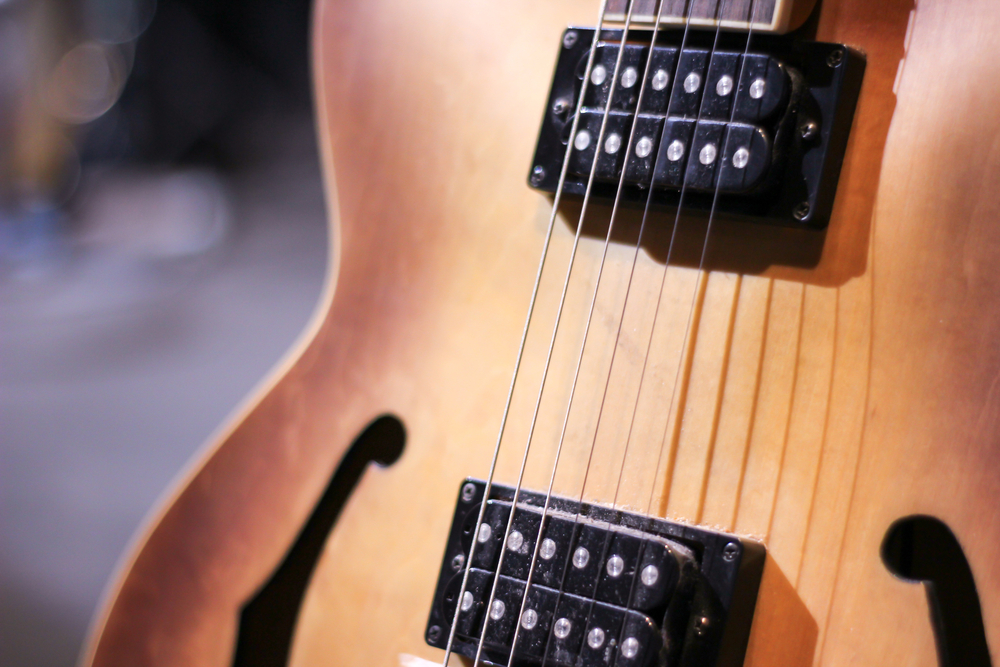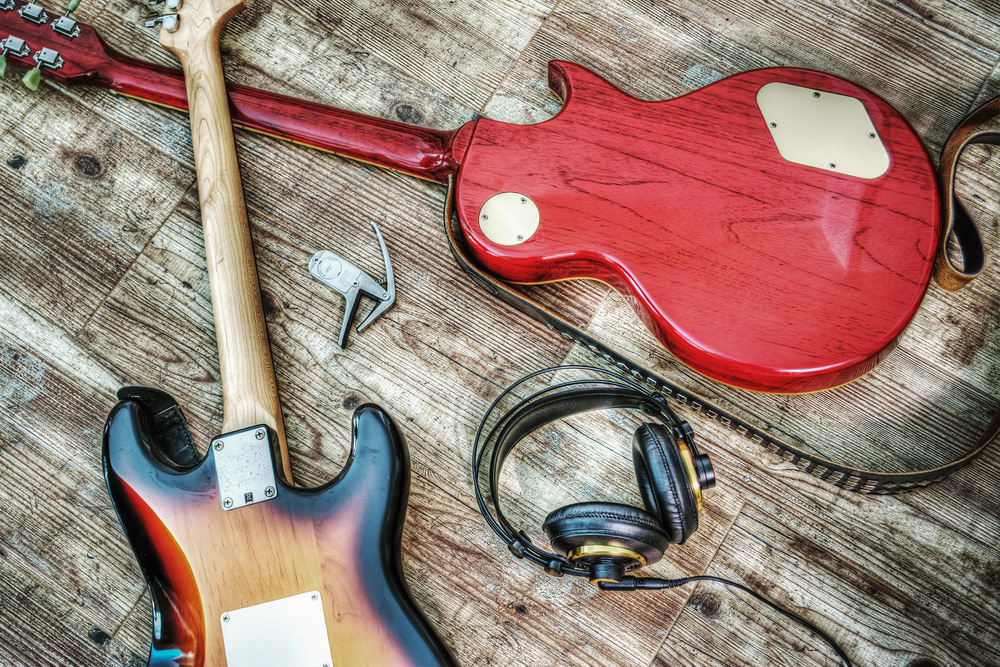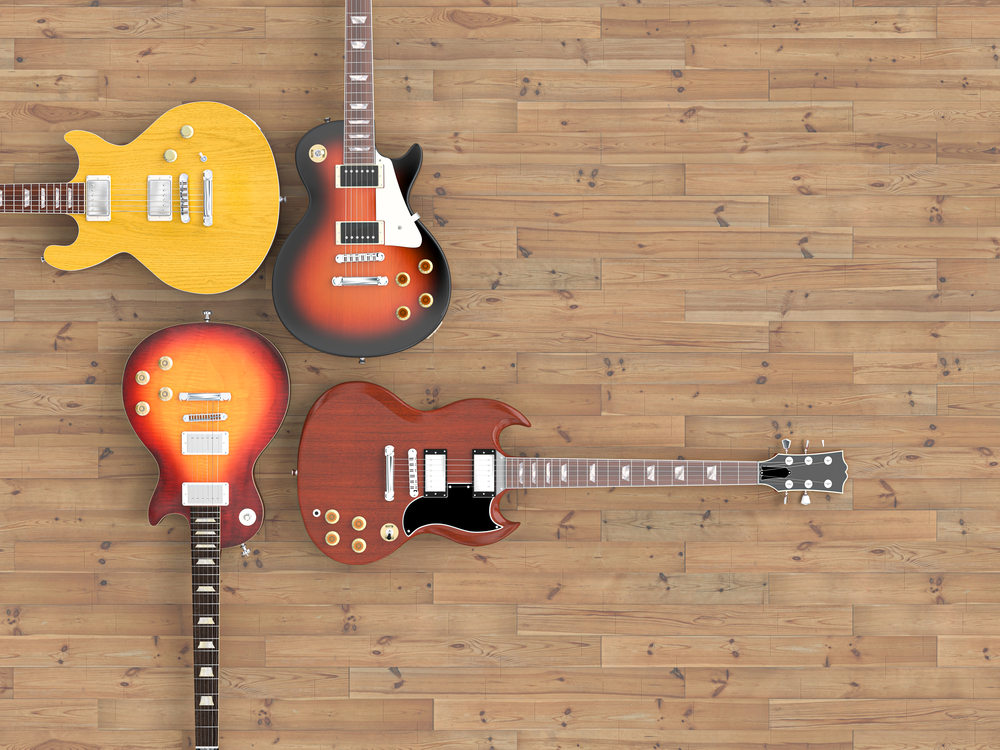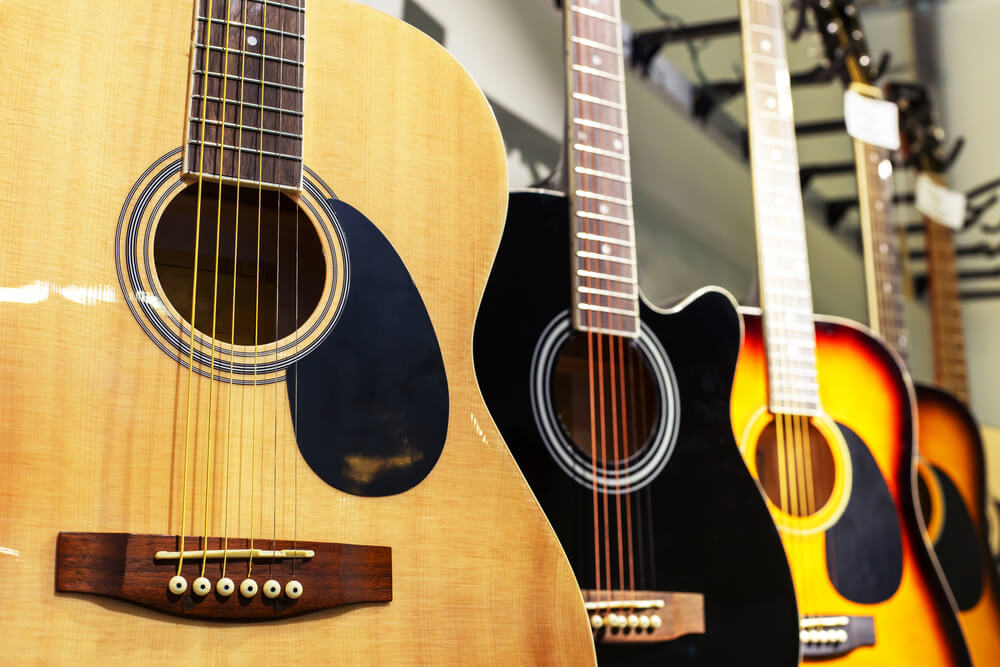The world of guitars is as vast and diverse as the musical landscape they help create. From the graceful curves of an acoustic guitar to the electrifying hum of a solid-body electric, these instruments have shaped the soundtrack of our lives. In this comprehensive guide, we’ll take you on a journey through the different types of guitars – from the familiar to the unconventional – and explore the unique characteristics that make each one special. So, whether you’re a seasoned guitarist or a curious beginner, get ready to discover new sonic territories and expand your musical horizons!
Short Summary
- Explore the wide range of guitar types, from acoustic and electric to unique variants like multi-neck guitars.
- Steel string acoustics are renowned for their bright sound, while nylon strings provide a warm tone ideal for classical music.
- Electric bass guitars offer versatility and portability with acoustic basses providing a mellow unplugged sound.
Acoustic Guitars: Exploring the Basics
Acoustic guitars, with their hollow bodies and resonant soundboards, are the epitome of versatility when it comes to stringed instruments. These timeless classics come in various shapes, sizes, and materials, each with its own distinct tonal characteristics.
At their core, acoustic guitars can be divided into two primary types: steel-string and nylon-string. Let’s delve deeper into the world of acoustic guitars and discover the nuances that make each type unique and well-suited for different styles of music, especially when it comes to the versatility of steel guitar strings themselves.
Steel-String Acoustic Guitars

When you think of an acoustic guitar, chances are you’re envisioning a steel-string acoustic. Known for their bright and loud tone, steel-string acoustic guitars are perfect for a variety of music genres, including folk, country, blues, and rock. These guitars come in various body styles, such as the iconic dreadnought, the compact parlour, and the large jumbo, each with its own unique sonic signature.
The choice of tonewood is crucial in shaping the sound of a steel-string acoustic guitar. Mahogany or rosewood back and sides, paired with a spruce top, are the most common combinations that deliver a balanced tonal palette. From fingerpicking folk tunes to strumming rock anthems, steel-string acoustic guitars provide the versatility and expressiveness that musicians adore.
Nylon-String Acoustic Guitars
For those seeking a mellower, more intimate sound, nylon-string acoustic guitars, also known as classical guitars, are the perfect choice. These guitars produce a warm and dark tone, ideal for classical music, flamenco, and fingerstyle playing. Unlike their steel-string counterparts, nylon-string guitars are typically played using fingerstyle techniques instead of a pick, allowing for greater control over dynamics and expression.
The nylon-string acoustic guitar’s close association with classical and European music styles has cemented its status as a sophisticated and refined instrument. Its gentle, soothing tones, produced by the nylon strings, can transport you to a candlelit concert hall or a sun-drenched Spanish courtyard, creating an evocative and immersive listening experience.
Electric Guitars: Plugging into Possibilities

When it comes to making a statement, electric guitars take center stage. These versatile instruments use magnetic pickups to convert string vibrations into electrical signals, which can then be shaped and manipulated through amplifiers and effects pedals to produce a staggering array of tones. Electric guitars have become synonymous with genres like rock, metal, blues, and jazz, where their powerful sound and distinctive character have left an indelible mark on the musical landscape.
The world of electric guitars can be broadly divided into two categories: solid-body and hollow-body/semi-hollow. Each type offers its own unique sonic possibilities, opening the door for endless experimentation and creative expression. In this section, we’ll explore the key differences between these two types of electric guitars and delve into the diverse sounds they can create.
Solid-Body Electric Guitars
Solid-body electric guitars, also known as solid body electric guitars, are among the most popular and versatile types of guitars. Their solid construction allows for a wide range of tonal options and hardware configurations, making them highly customizable to suit any player’s preferences. From the iconic Fender Stratocaster to the Gibson Les Paul, solid-body electric guitars have been the go-to choice for countless musicians over the years.
These two hollow body electric guitars are equally at home in the hands of a blues virtuoso or a shredding metal guitarist, their adaptable nature making them a staple in almost every genre of music. Whether you’re looking for a smooth and sultry jazz tone or a scorching, high-gain sound, solid-body electric guitars have got you covered.
Hollow-Body and Semi-Hollow Electric Guitars
For those seeking a more acoustic-like tone, hollow-body and semi-hollow electric guitars offer the perfect blend of electric and acoustic characteristics. These guitars have large, stylishly curved bodies that create resonant sound chambers, as well as electric guitar-style pickups. Their warm, full-bodied sound has made them a popular choice among jazz, blues, and rockabilly musicians.
The archtop guitar, a type of hollow-body electric guitar, is particularly favored by jazz guitarists for its rich and resonant tone. With their elegant design and timeless sound, hollow-body and semi-hollow electric guitars provide a sophisticated and versatile option for musicians seeking a more organic, acoustic-inspired electric guitar experience.
Electro-Acoustic Guitars: Best of Both Worlds
For those who want the best of both worlds, electro-acoustic guitars bridge the gap between acoustic and electric guitars. These hybrid instruments feature built-in pickups, allowing them to be amplified and used with effects processors, while still retaining the warm and natural tone of an acoustic guitar. Electro-acoustic guitars come in two main varieties: acoustic-electric and classical-electric, catering to both steel-string and nylon-string players.
Whether you’re a singer-songwriter looking to add depth and dimension to your live performances or a classical guitarist seeking greater amplification options, electro-acoustic semi acoustic guitars can offer a versatile and practical solution. In this section, we’ll explore the key features and benefits of these hybrid instruments, as well as the differences between acoustic-electric and classical-electric guitars.
Acoustic-Electric Guitars
Acoustic-electric guitars are steel-string acoustic guitars with built-in pickups, allowing them to be plugged into an amplifier or used with effects processors. They offer the same warm and resonant tone as a regular acoustic guitar, but with the added benefit of increased volume and control over the sound. With features like volume and tone toggles, as well as built-in tuners, acoustic-electric guitars provide a seamless transition between unplugged and amplified playing.
These versatile instruments are a popular choice for musicians of all genres, from folk to rock, and are especially well-suited for live performances, where the ability to boost the sound and utilize effects can make all the difference in creating a memorable and engaging show.
Classical-Electric Guitars
Classical-electric guitars are nylon-string acoustic guitars that, like their steel-string counterparts, come equipped with built-in pickups. They offer the same benefits as acoustic-electric guitars, such as the ability to plug into an amplifier or use effects, but with the warm and mellow tone characteristic of electric guitar strings on a classical guitar.
These hybrid instruments are particularly popular among classical, flamenco, and Latin guitarists, who appreciate the greater amplification and tonal control that classical-electric guitars provide.
Whether you’re a solo performer or part of an ensemble, the classical-electric guitar is an excellent choice for musicians seeking a versatile and expressive instrument with a rich, authentic tone.
Extended-Range Guitars: Pushing Boundaries
As the name suggests, extended-range guitars push the boundaries of traditional guitar design by incorporating additional strings to expand their tonal range and playing possibilities. These instruments come in various configurations, such as seven-string, eight-string, and even nine-string guitars, offering musicians a wider palette of notes and tunings to explore.
From heavy metal to jazz fusion, extended-range guitars are increasingly being embraced by musicians looking to break new ground and challenge the limits of their creativity. In this section, we’ll delve into the world of extended-range guitars and discover how these innovative instruments are changing the way we think about the guitar.
Seven-String Guitars
Seven-string guitars feature an extra low B string, providing an extended range that is particularly popular in heavy metal and progressive rock genres. The additional low end offers more power and depth to the instrument, allowing for heavier riffs and more complex chord voicings. While the seven-string guitar may require a slight adjustment in playing technique, it opens up a world of creative possibilities for musicians looking to push the boundaries of their sound.
From the thunderous chugs of modern metal to the intricate chordal work of jazz fusion, seven-string guitars have found a place in the hands of adventurous musicians across various genres. With their unique tonal range and versatile playing capabilities, seven-string guitars continue to redefine the limits of what a guitar can do.
Eight- and Nine-String Guitars
Taking the concept of extended-range guitars even further, eight- and nine-string guitars provide an even greater range of notes and playing possibilities. These instruments are often used in experimental and technical music styles, where their extended range allows for complex and unconventional compositions.
The sheer number of strings on these steel string guitars, including twelve string guitars, may seem intimidating at first, but for those willing to embrace the challenge, eight- and nine-string guitars offer a truly unique playing experience. From mind-bending chord progressions to lightning-fast solos, these instruments are a testament to the limitless potential of the guitar and the musicians who wield them.
Unique Guitar Variants: Exploring Unconventional Instruments

Beyond the realm of traditional guitars lies a world of unconventional instruments that defie convention and challenge the limits of what a guitar can be. From multi-neck marvels to harp-like hybrids, these unique guitar variants showcase the boundless creativity and innovation that can be found within the world of stringed instruments. In this section, we’ll take a closer look at some of the most fascinating and unconventional guitar designs and explore the creative possibilities they offer.
Whether you’re a seasoned guitarist looking to expand your sonic palette or a curious beginner eager to explore new musical territories, unique guitar variants provide a fresh perspective on the art of guitar playing. So strap in and prepare to venture into the unknown as we embark on this journey into the world of unconventional instruments.
Multi-Neck Guitars

Multi-neck guitars are an eye-catching sight, featuring two or more necks that allow for quick switching between different tunings or string configurations. These guitars are often used by musicians who require rapid access to multiple tonal options during a performance, such as switching between a six-string and a twelve-string neck for different sections of a song.
While multi-neck guitars may seem cumbersome and unwieldy, they offer a level of versatility and convenience that is unmatched by traditional single-neck guitars. From progressive rock epics to intricate jazz compositions, multi-neck guitars have found a place in the hands of musicians who strive to push the boundaries of their craft.
Touch Guitars
Touch guitars are a unique breed of instrument that utilizes a fretboard-tapping playing style, allowing musicians to use both hands on the frets for more complex and intricate playing. By tapping the strings directly onto the frets with both hands, players can achieve a level of speed, precision, and fluidity that is difficult to achieve with traditional picking or strumming techniques.
Whether it’s blazing solos or cascading arpeggios, touch guitars offer a fresh approach to guitar playing that challenges conventional techniques and expands the boundaries of what is possible on the instrument. For those looking to break free from the confines of traditional guitar playing, touch guitars provide a gateway to a world of new creative possibilities.
Harp Guitars
Harp guitars are a fascinating fusion of two distinct instruments, combining the traditional six-string guitar with additional unstopped strings that can be plucked like a harp. These extra strings create a deep, resonant harmony, while the four strings already on the harp guitar neck are used to play melodies or chords in a conventional manner.
With their striking design and unique tonal capabilities, harp guitars offer musicians a fresh and innovative approach to guitar playing. From the lush harmonies of fingerstyle arrangements to the ethereal soundscapes of ambient compositions, harp guitars are a testament to the boundless creativity that can be found within the world of stringed instruments.
Resonator Guitars
Resonator guitars are a distinctive type of guitar that uses metal cones instead of traditional soundholes to produce a loud, unique tone. These guitars were originally designed to be heard over the sound of brass and percussion instruments in large bands and have since become popular in genres such as country music such as blues and bluegrass music.
The characteristic tone of resonator guitars is often described as bright, metallic, and cutting, making them particularly well-suited for slide guitar techniques and fingerpicking styles. Whether you’re a blues enthusiast or a bluegrass picker, resonator guitars provide a unique and authentic voice that is sure to make an impression.
Bass Guitars: Laying the Foundation

Bass guitars are the unsung heroes of the band, providing the low-end foundation that supports and drives the music. These instruments are essential to creating a cohesive and powerful sound, filling out the sonic landscape with their deep, resonant tones. Bass guitars come in a variety of forms, from electric to acoustic, offering a range of options for musicians looking to lay down a solid groove.
In this section, we’ll explore the world of bass guitars and discover the key characteristics that set them apart from their six-string counterparts. From thumping funk lines to walking jazz basslines, bass guitars are the backbone of countless musical styles, proving that sometimes, it’s the low notes that make the biggest impact.
Electric Bass Guitars
The electric bass guitar is the most common type of bass guitar and offers a wide range of tones and playing styles. These instruments typically feature four, five, or six strings and are tuned an octave lower than an electric guitar. Electric bass guitars are available in solid-body, hollow-body, semi-hollow solid body electric guitar, and acoustic-electric models, providing a versatile range of tones and playing styles for musicians of all genres.
Whether you’re looking to slap and pop your way through a funk groove or lay down a smooth walking bassline for a jazz standard, electric bass guitars provide the foundation and versatility needed to support any musical style. With their powerful sound and distinctive character, electric bass guitars continue to shape the soundscapes of our favorite songs and genres.
Acoustic Bass Guitars
Acoustic bass guitars offer a unique alternative to their electric counterparts, featuring a hollow body that allows them to be played without amplification. These instruments are perfect for unplugged performances, practice sessions, or intimate settings where a full electric bass setup may not be practical.
Despite their acoustic nature, these bass guitars still provide a deep, mellow tone that is well-suited for a variety of musical styles. From laid-back coffeehouse gigs to impromptu jam sessions, acoustic bass guitars offer a portable and versatile option for musicians looking to lay down the low end without the need for an amplifier.
Summary
In this in-depth guide, we’ve explored the vast and diverse world of guitars, from the familiar acoustic and electric varieties to the unconventional and innovative extended-range and unique guitar variants. Each type of guitar offers its own unique tonal characteristics and playing possibilities, providing musicians with endless opportunities for creative expression and exploration.
As you venture forth into the world of guitars, remember that the instrument is only one part of the equation; it’s the passion, dedication, and creativity of the musician that brings these beautiful instruments to life. So, whether you’re a seasoned guitarist or just starting your musical journey, embrace the boundless potential of the guitar and let your imagination soar.
Frequently Asked Questions
What are 4 different types of guitar?
The four main types of guitars include acoustic, electric, classical, and bass. Acoustic guitars use vibrating strings to create sound directly, while electric guitars amplify the vibration from the strings through an amplifier. Classical guitars usually have wider fretboards and nylon strings, while bass guitars are tuned lower and produce deeper tones.
All of these guitars come in different shapes and sizes, providing players with a wide range of options to create unique sounds.
What are 3 different types of guitars?
Guitars come in three main varieties – Classical, Acoustic and Electric – that can accommodate different styles of playing. Each type produces a distinct sound, giving players a range of musical options.
Which guitar is best for beginners?
Steel-string acoustic guitars are a great option for beginners and experienced players alike due to their balance between price and quality. They’re perfect for strumming chords and singing along, and can be amplified in live situations. The downside of steel guitars is that they may not be as comfortable to play for those with smaller hands.
For those looking for an easy entry into guitar playing, electric guitars offer lots of possibilities. Electric guitars can be used to create many different sounds, styles and tones that wouldn’t be possible on acoustic instruments. However, they require additional equipment such as amplifiers and effects pedals.
Given these options, the best guitar for beginners is a steel-string acoustic guitar as it offers good quality and is great for strumming chords and singing along. It can be easily amplified for live performances, and is suitable for those with small hands.
What are the other types of guitars?
From classical and acoustic to electric, bass, and seven-string guitars, there is a wide variety of guitars that can be used for many different styles of music. Other popular types include the twelve-string guitar, the resonator guitar, lap steel guitars, the lap steel guitar, the baritone guitar, and the ukulele.
No matter the type of music, there is a type of guitar suited to it!
Can I use effects pedals with an electro-acoustic guitar?
Yes, it is possible to use effects pedals with an electro-acoustic guitar, provided it has a suitable pickup and preamp. With the right equipment, you can create a wide variety of sounds with your electro-acoustic guitar.



